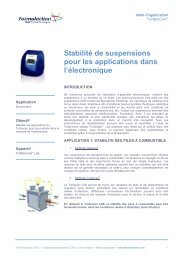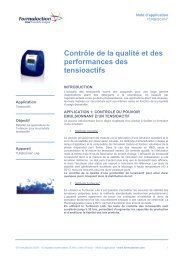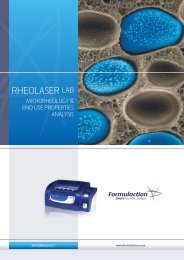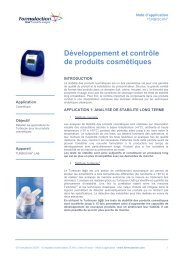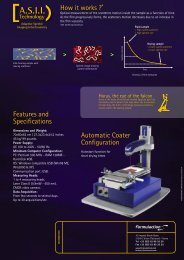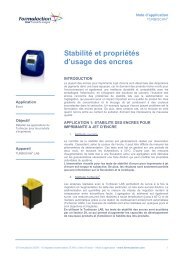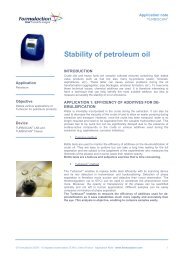Stability and use properties of pigment based inks - Formulaction
Stability and use properties of pigment based inks - Formulaction
Stability and use properties of pigment based inks - Formulaction
You also want an ePaper? Increase the reach of your titles
YUMPU automatically turns print PDFs into web optimized ePapers that Google loves.
Application<br />
Ink<br />
Objective<br />
Details various applications <strong>of</strong><br />
Turbiscan for printing products<br />
Device<br />
TURBISCAN ® LAB<br />
Application note<br />
TURBISCAN ®<br />
<strong>Stability</strong> <strong>and</strong> <strong>use</strong> <strong>properties</strong><br />
<strong>of</strong> <strong>pigment</strong> <strong>based</strong> <strong>inks</strong><br />
INTRODUCTION<br />
Most <strong>of</strong> the inkjet <strong>inks</strong> are now a dispersion <strong>of</strong> <strong>pigment</strong>s in a water base, as they<br />
give more environmentally friendly products that have also a better durability <strong>and</strong><br />
compatibility with the packaging. However, with going away from dye solutions, the<br />
ink industry faces stability issues such as sedimentation <strong>and</strong> aggregation that can<br />
have a great impact on the quality <strong>of</strong> the finished product. Concentration gradients<br />
<strong>and</strong> blocking <strong>of</strong> the jet leading to inconsistency <strong>of</strong> the colour through the cartridge life<br />
can appear. A typical example <strong>of</strong> <strong>inks</strong> causing problem are the yellow <strong>inks</strong> that are<br />
known for being the most difficult to formulate. Moreover, in some cases foam is<br />
created when the ink is jetted on the substrate, leading also to bad quality printing.<br />
APPLICATION 1: STABILITY OF INKJET INKS<br />
1. Common method<br />
Visual observation is usually <strong>use</strong>d to control the stability <strong>of</strong> inkjet <strong>inks</strong>. However,<br />
depending on the colour <strong>of</strong> the ink, it can be quite difficult to assess sedimentation<br />
phenomenon. These measurements are usually done during 2 months, with storing<br />
samples at 50°C. Moreover, particle size increase due to flocculation <strong>and</strong>/or<br />
aggregation are tricky to measure as a particle size analyser requires high dilution<br />
that can modify the colloidal <strong>properties</strong> <strong>of</strong> the system.<br />
The visual observation for stability tests <strong>of</strong> <strong>inks</strong> is tedious, subjective <strong>and</strong> time<br />
consuming. Moreover the results are only partial (no information on<br />
flocculation <strong>and</strong> kinetics).<br />
2. Turbiscan ® method<br />
The analyses performed with the Turbiscan LAB enable to monitor both migration<br />
<strong>and</strong> particle size increase without doing any dilution. The sedimentation is quantified<br />
through migration velocity so that formulations can be easily compared. Packing <strong>of</strong><br />
the sediment is also monitored. The analyses can be done at high temperature (up<br />
to 60°C) <strong>and</strong> automated via a fully automated ageing station (Turbiscan AGS). The<br />
stability measurements are done in only a couple <strong>of</strong> days, they are objective <strong>and</strong><br />
traceable.<br />
By using the Turbiscan LAB the stability tests <strong>of</strong> inkjet <strong>inks</strong> are accelerated by<br />
20, enabling to increase the development capacities for new products <strong>and</strong> to<br />
improve the reliability <strong>of</strong> the batches produced.<br />
© <strong>Formulaction</strong> 2009 - 10 impasse borde basse 31240 L'Union France - Application Note - www.formulaction.com 1
APPLICATION 2: FOAMABILITY OF INKS<br />
1. Common method:<br />
Application note<br />
TURBISCAN ®<br />
The formation <strong>of</strong> foam from a cartridge on the substrate leads to bad quality<br />
printings. It is therefore important to measure the foamability <strong>of</strong> ink <strong>and</strong> possibly the<br />
effect <strong>of</strong> anti-foams. These tests are usually performed by making the foam using an<br />
agitation device (ultrasounds, manual shaking, vibroshaker, etc.) <strong>and</strong> measuring<br />
visually the amount <strong>of</strong> foam created. The study <strong>of</strong> the breakage <strong>of</strong> the foam over<br />
time enables to monitor its instability.<br />
The investigation <strong>of</strong> foamability is therefore subjective <strong>and</strong> tedious.<br />
2. Turbiscan ® method:<br />
The Turbiscan LAB can measure easily the quantity <strong>of</strong> foam produced thanks to its<br />
scanning device. The foam can be created directly in the measuring cell using the<br />
same method as mentioned previously. The measurements over time allow a<br />
monitoring <strong>of</strong> the stability <strong>of</strong> the foam <strong>and</strong> a comparison <strong>of</strong> different products via<br />
kinetics calculated with the s<strong>of</strong>tware.<br />
The Turbiscan LAB enables to monitor the foamability <strong>of</strong> <strong>inks</strong> <strong>and</strong> to follow the<br />
stability <strong>of</strong> the foam created in an objective <strong>and</strong> traceable way.<br />
APPLICATION 3: RE-DISPERSION OF SEDIMENT<br />
1. Common method:<br />
It is difficult to avoid completely the sedimentation <strong>of</strong> the <strong>pigment</strong>s. For industrial<br />
printing, where the ink is stored in a tank before being <strong>use</strong>d in a continuous loop, the<br />
re-dispersibility <strong>of</strong> the <strong>pigment</strong>s is a key parameter. If they sediment in the tank, it is<br />
important to be able to re-disperse them easily. It can be quite difficult to measure<br />
the good re-dispersibility <strong>of</strong> a sediment <strong>and</strong> when the test is done it is only perform<br />
through visual observation.<br />
2. Turbiscan ® method:<br />
The Turbiscan LAB can also be <strong>use</strong>d to assess the re-dispersibility <strong>of</strong> the sediment<br />
in addition to the information obtained on its packing. This analysis is performed by<br />
measuring the sample before any sedimentation has occurred <strong>and</strong> after redispersion<br />
<strong>of</strong> the settled ink. If the backscattered level measured is the same in both<br />
cases, we can conclude that the sediment is not aggregated <strong>and</strong> can be redispersed<br />
easily. Otherwise, aggregation has occurred in the sediment <strong>and</strong> the ink<br />
cannot be <strong>use</strong>d. This is a quick <strong>and</strong> easy measurement that can be <strong>use</strong>d for quality<br />
control purposes.<br />
The Turbiscan LAB enables to get a quick <strong>and</strong> objective measurement <strong>of</strong> the<br />
re-dispersibility <strong>of</strong> a <strong>pigment</strong> in inkjet <strong>inks</strong>.<br />
CONCLUSION<br />
These different tests concerning various aspects <strong>of</strong> the quality <strong>of</strong> <strong>inks</strong> are done with<br />
the same apparatus, the Turbiscan LAB. They concern both R&D labs that develop<br />
new inkjet <strong>inks</strong> formulations with the best stability <strong>properties</strong> possible, <strong>and</strong> quality<br />
control departments that check the products at the end <strong>of</strong> the production line <strong>and</strong><br />
make long-term stability tests. Moreover, the technique can also be <strong>use</strong>d to study<br />
other types <strong>of</strong> ink (e.g. monitoring <strong>of</strong> the crystallisation <strong>of</strong> dye).<br />
© <strong>Formulaction</strong> 2009 - 10 impasse borde basse 31240 L'Union France - Application Note - www.formulaction.com 2



